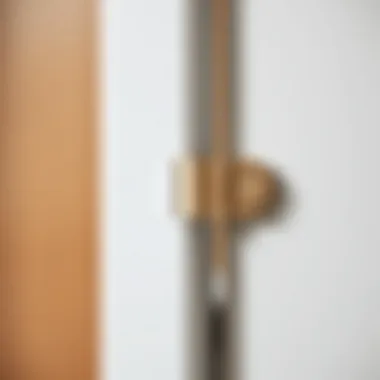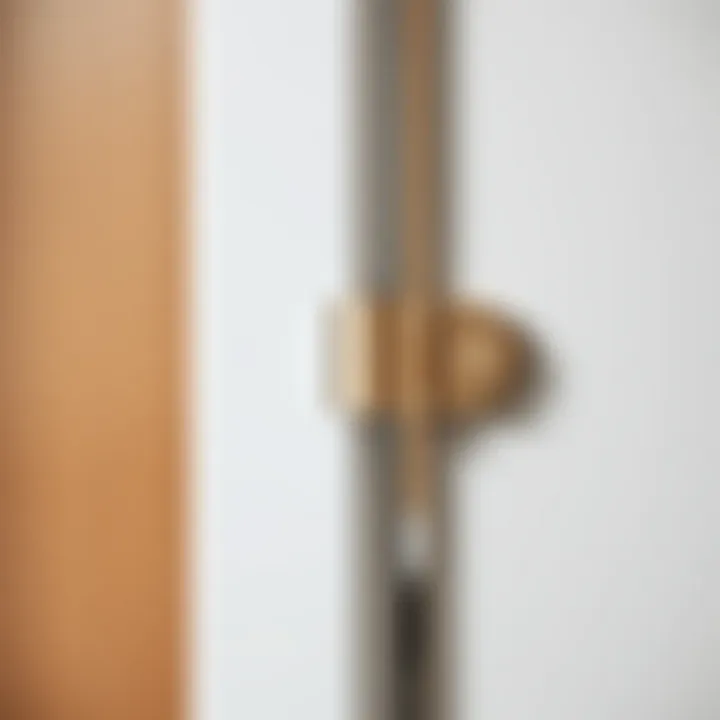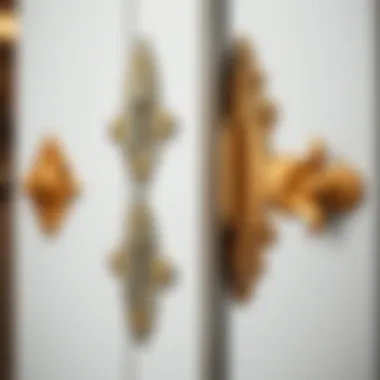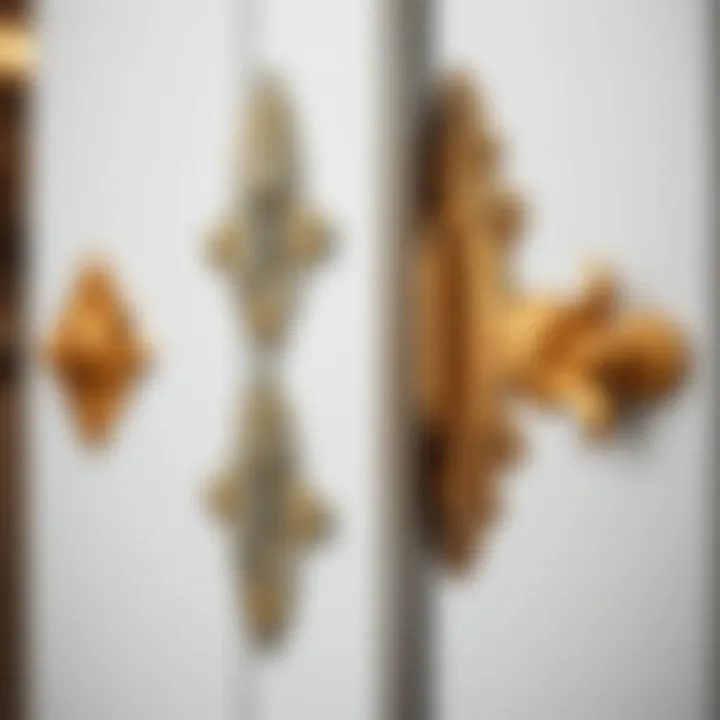Understanding Bathroom Vanity Door Hinges: Types and Tips


Intro
Design Inspirations
Trending Styles
As bathrooms evolve into personal sanctuaries, the design choices homeowners make extend even to what lies beneath the surface. Hinges, while often hidden, can reflect current trends. Here are some styles that stand out:
- Soft-Close Hinges: Perfect for a modern, sleek bathroom. These hinges prevent slamming and allow for a gentle, quiet closing motion.
- European Hinges: Known for their clean lines, these are great for contemporary designs, offering a seamless appearance inside cabinet boxes.
- Rustic or Vintage-Style Hinges: For those leaning towards a farmhouse or traditional look, decorative hinges made from wrought iron or brass can add warmth and character.
Color Palettes
Selecting a color for your hinges can also play a role in the overall look of your bathroom. Neutral metals such as black, satin nickel, or polished chrome pair well with most vanity styles:
- Black Hinge: Excellent for a striking contrast against white cabinetry or colored doors, giving a modern edge.
- Oil-Rubbed Bronze: Ideal for a warm, vintage aesthetic, particularly in rustic or traditional settings.
- Polished Gold: This can add a touch of luxury, particularly in bathrooms featuring marble or rich wood tones.
"Hinges can be the unsung heroes of bathroom design, subtly impacting both functionality and style."
Selecting the Right Hinge Type
When picking a hinge for your vanity, consider the following:
- Weight of the Door: Heavier doors require sturdier, heavy-duty hinges.
- Usage Frequency: If you open and close the doors often, choose hinges designed for high-frequency use.
- Door Installation Type: Whether the door is inset, overlay, or flush affects the type of hinge needed.
Installation Process
Installing hinges on vanity doors isn't as complicated as it may seem. Here’s a simplified overview:
- Choose the Right Tools: A drill, screwdriver, and a level will help ensure accuracy.
- Measure Carefully: Ensure you mark exact spots where the hinges will be mounted. There shouldn’t be any guesswork!
- Drill Pilot Holes: This will help prevent wood from splitting and also make the screws easier to insert.
- Attach the Hinges: Securely fasten the hinges to both the door and the cabinet face.
- Check Alignment: Before consider the job complete, ensure the door swings open freely and aligns properly.
Maintenance Tips
To keep your hinges functioning well, you should consider a bit of regular maintenance:
- Wipe Clean: Dust and grime can accumulate over time. A soft cloth can do wonders.
- Lubrication: Occasionally apply a suitable lubricant like silicone spray or specialized hinge oil to avoid squeaks.
- Inspect Regularly: Make a habit of checking if screws are tight and hinges are not rusting, especially in humid environments.
The End
Understanding bathroom vanity door hinges may seem trivial at first glance, but they hold significant weight in the overall design and functionality of your space. With a variety of styles to choose from and the potential for customization, hinges can blend seamlessly into your bathroom's design while ensuring ease of use. As you embark on your next home improvement project, keep these elements in mind to elevate your bathroom's style and effectiveness.
For further insights, consider exploring resources from Wikipedia and Britannica.
Understanding Bathroom Vanity Door Hinges
Bathroom vanity door hinges may not be the first thing that comes to mind when designing a bathroom, yet they play a crucial role in the functionality and aesthetics of this essential space. Understanding the various types of hinges and their specific roles can help homeowners make informed choices that not only enhance ease of use but also align with the overall style of the bathroom. This section aims to clarify what these hinges are, their purposes, and the significance they hold in bathroom decor.
Definition and Purpose
Bathroom vanity door hinges are mechanical devices that attach the door to the vanity frame, allowing it to swing open and closed. The purpose of these hinges goes beyond mere connectivity; they facilitate daily routines by offering access to the items stored within the vanity. High-quality hinges ensure that doors operate smoothly and quietly, making a difference in user experience. A well-functioning hinge can be the unsung hero of a bathroom, providing not just utility but also contributing to the seamless flow of design.
"A great hinge does more than just hinge; it sets the stage for how the entire vanity performs day in and day out."
Importance in Bathroom Design
When it comes to the aesthetic appeal of a bathroom, every detail counts, and hinges are no exception. They can significantly influence the overall look of the vanity. For instance, sleek, modern hinges complement contemporary designs, while ornate styles might enhance a vintage-inspired bathroom. Furthermore, selecting the right hinge can play into the theme of the room.
In addition to visual impact, the choice of hinges can also dictate how the vanity functions. Soft-close mechanisms, for example, prevent slamming, protecting both the doors and the items within the vanity. This blend of practicality and style is key; after all, who wants to struggle with a door that doesn’t open correctly or makes loud noises in a peaceful space?
Ultimately, understanding bathroom vanity door hinges allows homeowners to make decisions that marry form with function, ensuring that their choices elevate both the user experience and the design integrity of their bathrooms. This knowledge not only aids in the selection of practical options but also enhances the overall renovation or building process.
Types of Hinges for Vanity Doors
When selecting the right bathroom vanity door hinges, one must appreciate not just the function but also the subtle nuances that accompany each type. Hinges might seem like small components, but they can significantly influence the style and functionality of the space. This section dives into the different varieties of hinges utilized for vanity doors, exploring their benefits, applications, and aesthetic considerations.
Concealed Hinges
Concealed hinges, often referred to as hidden or internal hinges, are engineered to remain out of sight when the door is closed. This design creates a sleek and modern aesthetic, making them particularly popular in contemporary bathroom designs. Because they allow for a clean front face on the cabinetry, they can enhance the overall look of the vanity without draws attention away from the decor.
Benefits of concealed hinges include:
- Enhanced aesthetic appeal: By being hidden, they give a minimalist feel to the furniture.
- Easy adjustments: Most concealed hinges allow for screws that enable adjustments in three dimensions for precise door alignment.
- Quiet operation: The construction often provides a smoother, quieter door closure compared to other types.
Pivot Hinges
Pivot hinges function differently than standard side-mounted hinges, allowing the door to pivot around a fixed point at the top and bottom. This mechanism is particularly useful in situations where a full swing of the door may not be feasible due to space constraints. In modern sink areas, pivot hinges can be especially practical as they provide a unique room flow.
Some interesting points about pivot hinges include:


- Space-saving design: They require less clearance than traditional hinges, making them suitable for snug bathroom layouts.
- Versatility: They can work well on heavy doors or those that need to be opened widely, as they can distribute weight efficiently.
- Aesthetic options: Various finishes can keep up with different design themes, from luxurious gold to brushed nickel.
Continuous Hinges
Continuous hinges, also known as piano hinges, run the entire length of the door. They are typically used in situations where durability is paramount, providing even weight distribution and reinforced support. This type can be highly advantageous in family bathrooms where someone might lean on the doors, as the hinges offer exceptional sturdiness.
Key aspects of continuous hinges include:
- Strength and stability: They can withstand the test of time, reducing wear and tear at the fulcrum.
- Security: The length provides added security against tampering, making it a safe choice for cabinets that might need extra locking mechanisms.
- Variety of materials: They come in various materials, enhancing their applicability in both heavy-duty and aesthetic contexts.
Overlay Hinges
Overlay hinges are specifically designed for cabinets where the door overlaps the cabinet frame. This type is commonly found in traditional or transitional style vanities where doors are meant to fully cover the opening of the cabinet. Their ease of installation and adjustment makes them a popular choice.
Some notable points include:
- Effective coverage: They ensure that no visible gaps appear between the door and the cabinet, providing a clean, polished look.
- Accessibility: Because of their design, they can also increase access to the interior of the cabinet.
- Wide range of styles: They come in a variety of finishes that can coordinate with other hardware in the bathroom.
Butterfly Hinges
Butterfly hinges, recognizable by their unique shape and design resembling a butterfly's wings, are often used in decorative applications. They can be a beautiful touch for custom cabinetry or unique vanity designs. While they are not as commonly found as prevalent types, they contribute a distinctly charming character to the overall vanity design.
Considerations for butterfly hinges include:
- Aesthetic appeal: They add character and can be often found with intricate designs, enhancing traditional aesthetics.
- Artistry in design: When used in bespoke projects, they showcase the craftsmanship in custom cabinetry.
- Versatile uses: They can be employed in more than just bathrooms, finding a home in kitchens or outdoor settings.
Understanding the range of hinges available for bathroom vanities not only aids in the functionality of the doors but also contributes to the aesthetic essence of the bathroom as a whole. Choosing the right type of hinge can be the difference between a cookie-cutter look and a tailored, sophisticated feel.
Material Choices for Hinges
When it comes to bathroom vanity door hinges, the material they are made of is not just a matter of aesthetics, it plays a significant role in functionality and longevity. Selecting the right material can greatly enhance the durability, resistance to corrosion, and overall performance of these everyday components. This section delves into various materials used for hinges, offering insights on their specific properties and advantages, making it imperative for homeowners to make informed decisions.
Stainless Steel
Stainless steel hinges are often lauded for their robustness and resistance to rust and corrosion. In a bathroom setting where moisture is a given, these properties are essential. Stainless steel can withstand the humid environment typically found in bathrooms, ensuring that the hinges function smoothly over time without succumbing to wear and tear.
The finish on stainless steel hinges can vary from brushed to polished, allowing for a range of design compatibility. Furthermore, they are relatively easy to maintain. A simple wipe down with a damp cloth can keep them looking new for years.
Stainless steel is an investment for the future—it ensures functionality remains intact in demanding environments.
Brass
Brass hinges add an element of elegance and warmth to bathroom vanities. The characteristic gold-like shine of brass can easily elevate the overall appearance of a bathroom. However, beauty aside, brass is also quite durable. While it does require some attention to maintain its luster and prevent tarnishing, its strength keeps the doors secure and operational.
In choosing brass, it's wise to consider options with protective coatings that can minimize maintenance tasks. Importantly, brass alloys can contain antimicrobial properties, offering an added layer of hygiene, which is particularly beneficial in a space where cleanliness matters.
Plastic and Composite Materials
For those looking for a budget-friendly alternative, plastic and composite materials make for viable hinge choices. They are lightweight and can often be molded into various styles to fit different designs. While they may not have the same weight and feel as metal, they offer resistance to rust, making them suitable for damp environments.
Plastic hinges can also be found in various colors and finishes, allowing for customization in design. On the downside, they might not hold up as long under heavy use compared to metal options. If a budget is a concern and aesthetic appeal is flexible, these materials could offer a good compromise between price and performance.
In summary, choosing the right material for bathroom vanity hinges is essential for optimizing both functionality and visual appeal. Each option has its unique strengths and weaknesses, making it vital to consider the specific needs of your bathroom environment before making a final choice.
Installation Process for Bathroom Vanity Hinges
When it comes to bathroom vanity door hinges, the installation process is a crucial aspect that homeowners often overlook. The proper installation of hinges ensures that doors function smoothly and lasts longer. It’s not just a matter of attaching a couple of pieces; it involves understanding the mechanics behind how these hinges operate and how they interact with the cabinetry. This section will delve into the essentials needed to get the job done right.
Essential Tools and Equipment
Before diving into installation, having the right tools is half the battle won. Here’s what you’ll need:
- Screwdriver: A Phillips or flathead screwdriver, depending on the screws used.
- Drill: A power drill for quicker and more precise holes.
- Measuring tape: For accurate measurements to ensure proper alignment of the hinges.
- Level: This will help in ensuring that the doors hang straight.
- Clamps: Useful for holding pieces in place while you install.
- Stud finder: If you're installing into the wall or using heavy doors, this tool can help find the best anchoring points.
Having all these tools at your side will significantly ease the installation process.
Preparing for Installation
Preparation is key. Before any actual work begins, it’s essential to follow these steps:
- Select Your Hinges: Choose hinges that match both the style and weight of your vanity doors.
- Read Instructions: Each type of hinge may have specific instructions. Taking a moment to understand these can save you time.
- Measure Twice: Measure the heights and widths of your doors, and where the hinges need to be attached. This is where the old saying "measure twice, cut once" really shines.
- Mark the Placement: Mark clearly where each hinge will be installed on both the cabinet and the door. Precision at this stage is crucial for the overall look and functionality.
Taking these preparatory steps can save you from potential headaches down the line.
Step-by-Step Installation Guide
Now, for the meat of the matter—actually installing those hinges. Here’s a simple guide that walks you through the process:
- Position the Door: Hold the door up to the cabinet to check the alignment. Use your level to make sure it's perfectly straight.
- Attach the Hinges to the Door: Begin by securing the hinges to the door using your screws. Don’t overtighten just yet; you might need to make slight adjustments during installation.
- Secure the Door to the Cabinet: Now, lift the door into place and mark where the second part of the hinge will go on the cabinet itself. This might require another round of measuring.
- Drill Holes: Once marked, drill the necessary holes in the cabinet for the hinge screws. Ensure no chips or splinters are present which may affect the hinge's grip.
- Attach the Hinges to the Cabinet: Secure the hinges into place, checking once again with your level to see if everything lines up.
- Adjust if Needed: This means testing the door movement. If it sticks or moves irregularly, you may need to loosen the screws and adjust the position slightly.
- Final Tightening: Once satisfied with the movement and position of the door, go ahead and tighten all screws fully.


Using soft-close hinges can make a world of difference in functionality. It offers a more practical and softer approach, so if you’re opting for those, be sure to follow the specific instructions for installation.
After finishing these steps, it’s advisable to test the door several times to ensure everything is working smoothly. You should be able to open and close it with ease, without any jarring or misalignment. Proper installation not only gives your bathroom a seamless look but also enhances the longevity of the hinges and the doors themselves.
Common Issues with Vanity Door Hinges
Bathroom vanity door hinges are a fundamental component, providing not just functional utility but also contributing to the visual appeal of the cabinetry. Understanding the common issues that may arise with these hinges is essential for homeowners. Identifying problems early on can prevent costly repairs and ensure that your vanity doors operate smoothly for years to come. This section delves into the most frequent concerns associated with vanity door hinges, along with practical solutions to mitigate them.
Misalignment of Doors
One of the most common frustraions with bathroom vanity doors is misalignment. This often occurs when the hinges are not properly installed or when wear and tear accumulate over time. Misaligned doors can lead to unsightly gaps or even obstructed access, making the bathroom look unfinished and cluttered. In extreme situations, improperly aligned doors may fail to function correctly, becoming difficult to open or close.
When doors do not align, checks should be made on the hinge installation. To rectify this, one can adjust the hinges by loosening the screws a bit, realigning the door, and then tightening them again. It’s worth noting that sometimes minor adjustments can restore that snug fit that you initially had.
"A little tweak here and there might save you from a major overhaul down the line."
Squeaking and Noisy Operation
Squeaking hinges can be a nagging annoyance, especially in a peaceful home environment. The unsettling sound usually stems from a lack of lubrication or debris accumulation. Over time, dirt and grime can build up, causing friction and resulting in that dreaded squeak with each opening or closing of the door.
To address this issue, regular maintenance is key. Cleaning the hinge thoroughly with a damp cloth can remove dirt, followed by the application of a suitable lubricant, such as silicone spray or graphite powder. This act of mercy not only helps in smoothing out the operation but can extend the life of the hinges as well. Ignoring the noise can lead to more significant issues later, affecting the functionality of the vanity.
Rust and Corrosion
Bathrooms typically have high humidity levels, creating the perfect storm for rust and corrosion to set in. Hinges, particularly those made from metals that are not rust-resistant, can quickly become an eyesore, and worse, they can compromise the structural integrity of the doors. Rust can lead to failure in hinge performance, requiring replacements that could have been avoided with adequate maintenance.
Homeowners should take preventive measures seriously. Opting for stainless steel or brass hinges can be a long-term investment, resisting corrosion effectively. Regular inspections are also crucial. Just a quick wipe down with a damp cloth after showering can help cut down on moisture buildup. Consider applying a protective sealant designed for bathroom fixtures to enhance longevity.
Addressing these issues will not only maintain functionality but will also preserve the aesthetic value of your bathroom vanity, ensuring it stands the test of time.
Maintenance Tips for Bathroom Vanity Hinges
Keeping your bathroom vanity door hinges in tip-top shape is vital for both functionality and aesthetics. Neglecting these small yet crucial components can lead to issues that affect the overall operation of the doors. Maintaining hinges is not just about repair; it’s about ensuring a smooth, hassle-free experience each time you open or close those doors. A well-maintained hinge not only prolongs its lifespan but can also significantly enhance the appearance of your entire vanity setup.
Cleaning Procedures
One crucial aspect of hinge maintenance is regular cleaning. Over time, dust, grime, and moisture can accumulate on hinges, causing them to function poorly or, worse, rust. A simple yet effective cleaning procedure includes the following steps:
- Gather Your Supplies: Start with a microfiber cloth, warm soapy water, and a soft brush, like a toothbrush, to reach into those crevices.
- Initial Wipe Down: Use the microfiber cloth to wipe down the hinge, removing any visible dust or residue.
- Soap Solution: Dip a soft brush into the soapy water and gently scrub the hinge. Pay attention to the areas where dirt tends to hide.
- Rinse and Dry: Rinse the hinge with a damp cloth and ensure to dry it thoroughly afterward. This’ll help prevent any moisture from lingering and causing rust.
Following these steps regularly can keep your hinges clean and functioning well.
Lubrication Techniques
Once the hinges are clean, it’s time to move on to lubrication. Proper lubrication is key in ensuring the hinge operates smoothly without squeaking or catching. Here’s how to do it:
- Choose the Right Lubricant: Look for a silicone spray, grease, or even a good ol’ WD-40. You want something that will not attract dirt while providing adequate protection.
- Application: Apply a small amount of lubricant to the pin of the hinge. If using a spray, ensure to cover the areas that move.
- Wipe Off Excess: After applying, wipe off any excess lubricant to avoid drips or staining your vanity.
Remember, it’s better to apply a little and add more if needed than to over-saturate the hinge. Doing this every few months can keep squeaks at bay and aid in smooth functionality.
Regular Inspections for Longevity
Lastly, incorporating a regular inspection routine can be beneficial. Take a moment every few months to check on your hinges. Here’s a simple checklist to follow:
- Look for Misalignment: Check if the doors are properly aligned. Uneven gaps can indicate a hinge issue that might need immediate attention.
- Check for Rust or Corrosion: If you spot any rust spots, it may be time to replace the hinge to prevent further damage.
- Tighten Screws: Ensure that screws are tightened appropriately. Loose screws can lead to a door that hangs unevenly.
Regular vigilance goes a long way in preserving the integrity of your bathroom vanity hinges. By engaging in these practices, you can enjoy a functional and stylish bathroom for years to come.
Incorporating these maintenance tips into your routine will enhance the longevity and aesthetic of your bathroom's vanity doors, ensuring that they remain both functional and visually appealing.
Design Considerations for Bathroom Vanity Doors
When it comes to designing a bathroom vanity, the door hinges might not be the first thing that springs to mind. Yet, considering these components is critical to achieving a harmonious blend of style and functionality in this often-used space. The door hinges serve more than just a purpose of opening and closing— they contribute to the overall look, feel, and usability of the vanity.
A well-thought-out design allows the bathroom vanity doors to not only perform efficiently but also enhance the aesthetics of the bathroom. It’s like picking the right frame for a beautiful painting; the right hinge unlocks the potential of the whole piece.
Matching Aesthetics with Functionality
Selecting hinges that align with the design of the vanity is crucial. For instance, a modern, sleek vanity can be complemented with concealed hinges that remain hidden when the doors are closed. This creates a minimalist appearance. Alternatively, if your bathroom embraces a traditional design, you may want to explore more decorative options, such as ornate butterfly hinges or classic brass choices that can add that extra touch of elegance.
It's important to remember that aesthetics aren't just about looks. Functionality plays a vital role. Hinges should provide smooth operation while supporting the weight of the door. If the hinges struggle with these demands, you'll quickly find that their visual appeal is undermined by poor performance.
Choosing Colors and Finishes
The colors and finishes of the hinges should be in sync with the vanity and the overall bathroom decor. A stainless-steel finish could blend well with a modern bathroom featuring metallic accents, while oil-rubbed bronze may suit a rustic theme better. Here are few tips to consider when selecting colors and finishes:
- Consider the existing decor: A cohesive look across fixtures enhances the visual appeal.
- Match the style: Traditional styles often benefit from brass, while contemporary design leans towards chrome or stainless steel.
- Think durability: Finishes such as chrome or powder-coated options may offer better resistance to moisture and tarnishing than standard brass.


Each choice reverberates throughout the whole room, emphasizing or undermining your desired aesthetic.
Influence of Hardware on Overall Design
Hardware, including hinges, can profoundly influence the overall design of your vanity. It’s not merely about function; it contributes to the complete atmosphere of the space. A piece of well-chosen hardware acts like jewelry for your vanity— a small but striking element that can command attention.
Here’s how to evaluate hardware influence:
- Style Integration: Ensure that the hinge style supports the broader theme of the bathroom. If your vanity has rustic charm, consider implementing vintage-style hinges.
- Scale and Proportion: Oversized hinges may overpower a small door, while tiny hinges can become lost on a larger vanity. Finding the right scale is key.
- Material Harmony: The same material should be echoed in other elements, like drawer pulls or cabinet knobs, fostering a seamless feel throughout.
In summary, the hinges of your bathroom vanity might seem like a small detail, but they’re a cornerstone of both functionality and design. Choosing the right hinges involves more than just picking a suitable type; it’s a thought-out process that factors in aesthetics, functionality, finishes, and hardware style to create a unified look. Taking the time to consider these elements can transform a simple bathroom into a space of elegance and efficiency.
Innovative Hinges and Modern Trends
When it comes to the bathroom, the hinges may often sit in the background, but they play a critical role in both functionality and style. As design trends evolve, so do the hinges designed for them. This section dives deep into the innovations and modern trends shaping the world of bathroom vanity door hinges. From enhancing convenience to merging aesthetics with practicality, understanding these trends helps homeowners make informed decisions that elevate their spaces.
Soft-Close Mechanisms
One of the most sought-after features in contemporary bathroom vanities is the soft-close mechanism. This innovation allows the doors to close gently and quietly, eliminating the loud thud that often accompanies traditional hinges. The appeal lies in its blend of safety and convenience—no more pinched fingers or startled guests with slamming doors.
The way soft-close hinges function is quite ingenious. They typically use a combination of hydraulic systems and friction to slow the closing action of the door. Homeowners get to enjoy a serene environment, a crucial aspect in spaces dedicated to relaxation. Moreover, these soft-close mechanisms can prolong the life of cabinetry by reducing overall wear and tear on both the hinges and the doors.
Damping Hinges for Smooth Operation
Taking the benefits of soft-close a step further, damping hinges provide an even smoother operation. The damping technology not only softens the closing motion but also controls the speed at which the door opens, ensuring a ballet-like movement.
Such hinges often incorporate sophisticated engineering, like adjustable dampers that can customize the opening and closing resistance to one's needs. This feature is a boon for busy households, eliminating those jerky openings that can happen with lesser quality alternatives. Heightened ease of use translates to a more enjoyable experience in the space, which is absolutely a win-win.
Smart Hinges in Contemporary Designs
In today’s tech-savvy world, even bathroom features have become smarter, and hinges are no exception. Smart hinges integrate technology for enhanced functionality. This can mean sensors that automate door operations or connectivity with home systems that allow for smart home integration.
Imagine a hinge that automatically closes as you walk away or a design that helps keep the bathroom tidy by alerting residents when something is ajar. These advancements cater to a tech-driven lifestyle while maintaining practicality. For modern homeowners, having state-of-the-art hardware in a bathroom not only improves day-to-day efficiency but also enhances property value.
"Innovation in hinges transcends mere aesthetics; it’s about elevating functionality and comfort in daily routines."
By looking to the future and leveraging these modern trends, homeowners can ensure their bathrooms are not only designed for beauty but also equipped with the latest conveniences. As needs evolve and lifestyles become more dynamic, embracing innovative hinge solutions can turn standard vanity doors into standout features of a refined bath space.
Selecting the Right Hinge for Your Bathroom Vanity
Choosing the right hinge for a bathroom vanity is crucial. This seemingly small component can significantly influence the functionality and elegance of your bathroom. Selecting a hinge involves more than just choosing a style; it’s about understanding how it complements the door's operation and overall design of your vanity. The functionality of your bathroom hinges dictates how the doors open and close smoothly, and this small detail can impact your daily routine, aesthetics, and even how long the doors last.
Assessing Your Specific Needs
Before diving into the various hinge options available, it’s important to assess your specific needs. Consider the following aspects:
- Door Weight and Size: Heavier doors require sturdier hinges that can support their weight without sagging.
- Frequency of Use: If your vanity sees a lot of action, it’s wise to choose more durable hinges; those soft-closing ones might fit the bill.
- Space Constraints: Measure the clearance around your vanity door. Some hinges might need more room to work properly.
Assessing these factors can help narrow down your choices, ensuring that you pick a hinge that matches your functional requirements and enhances the overall design.
Consulting Design Resources
When in doubt, seeking out design resources can be a game-changer. Architects and designers often have specific recommendations based on their extensive experience. Here are several resources that can come in handy:
- Home Improvement Magazines and Websites: These often feature the latest trends and expert reviews on hinges suitable for bathroom vanities.
- Social Media Platforms: Pinterest and Instagram can provide inspiration and practical ideas from real-life applications.
- Community Forums: Engaging with forums such as Reddit, or joining Facebook groups dedicated to home improvement can yield valuable insights from others who have been in your shoes.
Utilizing these design resources not only offers insight into current trends but also demonstrates what hinges work well in practice.
Balancing Cost and Quality
Finding the right hinge involves balancing cost and quality - a tightrope walk if ever there was one. It’s tempting to cut corners and choose cheaper options, but consider the long-term implications. High-quality hinges can be more cost-effective in the long run as they often come with durability guarantees and require less maintenance. Here are some things to ponder when thinking about cost versus quality:
- Material Durability: Stainless steel will typically be more resistant to rust compared to plastic, but it might come with a higher price tag.
- Warranty: A longer warranty generally indicates greater product confidence from the manufacturer.
- Installation Costs: If you’re considering professional installation, lower-cost hinges may not always be the best option, as savings might quickly evaporate when factoring in installation fees.
Take the time to evaluate what you value more in your hinge choice – is it a lower upfront cost or long-term reliability? Striking that balance can ultimately lead to a more satisfying purchase.
Remember, the details make the design! The right hinge can seamlessly combine functionality with your aesthetic vision, turning a simple vanity into a stylish centerpiece.
Ending
The importance of bathroom vanity hinges cannot be overstated. While they may seem like a small detail in the grand scheme of bathroom design, they play a critical role in both functionality and style. A well-chosen hinge can enhance the durability of the doors, allowing for smooth operation over time. It’s not merely about how the doors open and close; it’s about the experience of using them daily. With various types and materials available, selecting the appropriate hinge requires careful consideration of your bathroom's design, the weight of the doors, and how often they will be used.
Recap of Key Points
- Types of hinges: From concealed to butterfly hinges, each type serves a unique purpose and suits different design aesthetics.
- Material matters: Whether you choose stainless steel for durability or brass for elegance, the material directly affects the performance and lifespan of the hinges.
- Installation practices: Knowing the right tools and procedures for installation can save homeowners time and frustration before embarking on a renovation project.
- Common issues: Understanding problems like misalignment and squeaking and how to resolve them ensures longevity and maintenance ease of your vanity doors.
Final Thoughts on Bathroom Vanity Hinges
In summary, bathroom vanity door hinges are more than a mere hardware choice; they're an integral component that ties together functionality and style. Homeowners should not overlook their importance during renovations or remodels. Making an informed decision about the type and design of your hinges can significantly enhance both the utility and appearance of your bathroom.
Selecting the right hinges exemplifies the careful balance between aesthetics and functionality. Paying attention to this detail elevates your space and contributes to an overall sense of satisfaction in your home.
When designing or upgrading a bathroom environment, take the time to assess your needs and consult available resources, whether they be home improvement forums like Reddit or educational resources on sites such as Wikipedia. A thoughtful approach to your hinge selection will not only enrich the bathroom's aesthetics, but it can also ensure a seamless and enjoyable experience for years to come.



